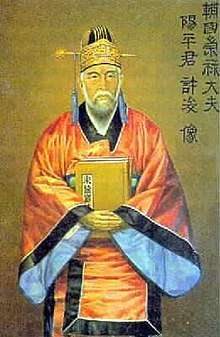Heo Jun
Heo Jun (허준, 1546 – 9 October 1615) was a court physician of the Yangcheon Heo clan during the reign of King Seonjo of the Joseon Dynasty in Korea.[1]
| Heo Jun | |
 | |
| Korean name | |
|---|---|
| Hangul | |
| Hanja | |
| Revised Romanization | Heo Jun |
| McCune–Reischauer | Hŏ Chun |
| Pen name | |
| Hangul | |
| Hanja | |
| Revised Romanization | Guam |
| McCune–Reischauer | Kuam |
| Courtesy name | |
| Hangul | |
| Hanja | |
| Revised Romanization | Cheongwon |
| McCune–Reischauer | Ch'ŏngwŏn |
Background
He was appointed as a court physician at the age of 29. He wrote a number of medical texts, but his most significant achievement is Dongui Bogam (lit. "Mirror of Eastern Medicine"), which is often noted as the defining text of traditional Korean medicine. The work spread to East Asian countries like China, Japan, and Vietnam where it is still regarded as one of the classics of Oriental medicine today. Although Heo Jun worked extensively with the royal family, he put a great emphasis on making treatment methods accessible and comprehensible to common people. Whereas common medical practice was to elevate the perceived value of treatment by using rare and expensive ingredients, he instead found natural herb remedies that were easily attainable by commoners in Korea and that were just as effective. Furthermore, he wrote the names of the herbs using the simple hangul letters instead of using more difficult hanja (Chinese characters), which most commoners did not understand.[2][3]
Heo Jun's name and accomplishments are widely recognized by Koreans even today. Korean people still refer to Heo Jun's natural remedies found in his Dongui Bogam.
In popular culture
Films and television
- Portrayed by Kim Mu-saeng in the 1975 MBC TV series Jibnyeom.
- Portrayed by Lee Soon-jae in the 1976 film Jibnyeom.[4]
- Portrayed by Seo In-seok in the 1991 MBC TV series Dongui Bogam.
- Portrayed by Jun Kwang-ryul in the 1999-2000 MBC TV series Hur Jun.[5]
- Portrayed by Kim Joo-hyuk and Kang Han-byeol in the 2013 MBC TV series Hur Jun, the Original Story.[6][7][8][9]
- Portrayed by Yoon Shi-yoon and Kim Kap-soo in the 2016 JTBC TV series Mirror of the Witch.
- Portrayed by Um Hyo-sup in the 2017 TVN TV series Live Up to Your Name, Dr. Heo.
Literature
- The novel Dongui Bogam by Lee Eun-seong was published in 1990, and became a bestseller.
References
- 허준 許浚 (1539 ~ 1615) [Heo Jun] (in Korean). Doosan Encyclopedia. Retrieved 2009-09-18.
- Han, Sang-hee (31 July 2009). "Mirror of Eastern Medicine Becomes UNESCO Heritage". The Korea Times. Archived from the original on 13 December 2013. Retrieved 2013-03-20.
- Chung, Ah-young (7 August 2009). "Korean of Dongui Bogam Unveiled". The Korea Times. Archived from the original on 13 December 2013. Retrieved 2013-03-20.
- "Concentration Of Attention (Jibnyeom) (1976)". Korean Movie Database. Archived from the original on 2013-04-13. Retrieved 2013-03-20.
- Lee, Sang-min (February 2013). "Historical Drama and Future". KOFICE WebZine. Archived from the original on 2014-03-24. Retrieved 2013-03-20.
- Kang, Hyo-jin (6 March 2013). "Kim Joo Hyuk seeks to bring his new interpretation of Heo Jun in Gu Am Heo Jun". Korea Star Daily via Yahoo!. Archived from the original on 1 August 2013. Retrieved 2013-03-20.
- "Hur Jun, the Original Story script reading of MBC's new drama series". MBC Global Media. 7 March 2013. Retrieved 2013-03-20.
- Oh, Jean (13 March 2013). "Period piece overload? Spring drama lineup goes heavy on historical settings". The Korea Herald. Retrieved 2013-03-20.
- "Hur Jun, the Original Story Casts Interview". MBC Global Media. 9 April 2013. Retrieved 2014-06-13.